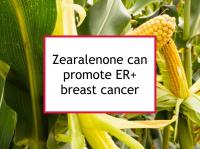Zearalenone is a mycoestrogen that widely contaminates cereal grains such as corn. It is produced by fusarium fungi and shares similar molecular mechanisms and activity with mammalian estrogens. This has lead to concerns about zearalenone's potential to promote estrogen-sensitive breast cancer. Now a new study has reported that zearalenone at levels found in the food supply can promote ER+ breast cancer.
Zearalenone infected corn
Zearalenone contamination is widespread. The contamination by fungi and their mycotoxins can occur either in the field or during storage of grains for distribution. Although the FDA has not provided specific guidance levels for zearalenone in corn, its guidance for aflatoxin (another mycotoxin, which is known to cause liver cancer) serves to reduce exposure to both. Farmers do attempt to minimize zearalenone occurrence, however it would be challenging to determine to the zearalenone level of any corn, corn tortillas, masa or corn oil sold at retail.
Beef and lamb are sources of closely-related compound
The related compound zeranol is widely used used in non-organically raised cattle and lambs as a growth promoter to improve fattening rates. Like zearalenone, zeranol has been found to stimulate human breast cancer cell growth and proliferation. The widespread use of soybean meal-based feeds incorporating soy isoflavones has raised questions regarding the potential for heightened estrogenic effects of the combination. One study that examined various mixtures of isoflavones and mycoestrogens reported that most combinations tested enhanced the estrogenic response. This was especially true of low concentrations of zeranol and related compounds in combination with low concentrations of soy isoflavones (genistein, daidzein and equol), which strongly increased the estrogenic response compared to the single substances.
Latest research finds low zearalenone promotes ER+ disease
The study referenced above was designed to investigate the potential risks of zearalenone exposure in both ER+ and ER- breast cancer cells and to uncover its mechanism of action. The authors hypothesized that zearalenone could act as a causative factor in breast cancer based on its similarity to naturally occurring estrogens.
Low zearalenone concentrations (similar to the real environment) were found to promote proliferation, migration and invasion in ER+ breast cancer cells. On the other hand, high concentrations of zearalenone inhibited malignancy in both ER+ and ER- breast cancer cells.
Zearalenone demonstrated the same biphasic effect (i.e., breast cancer promotion at low dose and breast cancer inhibition at high dose) on cell stemness and epithelial mesenchymal transition (EMT) processes. EMT enables an epithelial cell to acquire enhanced migratory capacity and invasiveness, as well as increased resistance to apoptosis (a type of programmed cell death). This was confirmed to be controlled by the Hedgehog pathway, a signaling pathway involved in tissue repair and regeneration that has been implicated in various cancers. The authors conclude that their results highlight the health risks posed by zearalenone, which merit more attention in environmental management.
